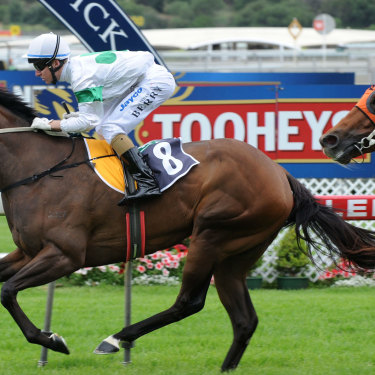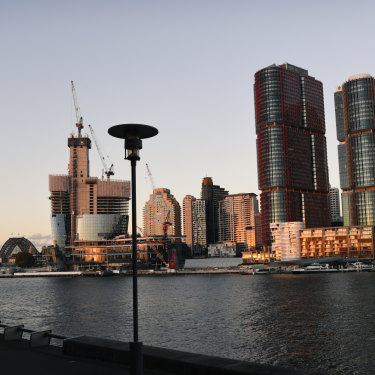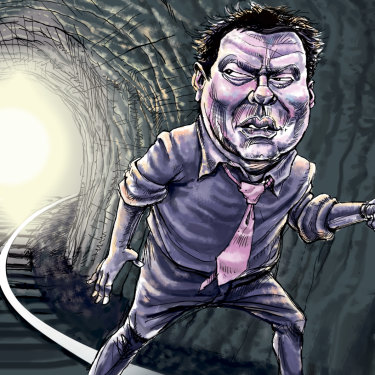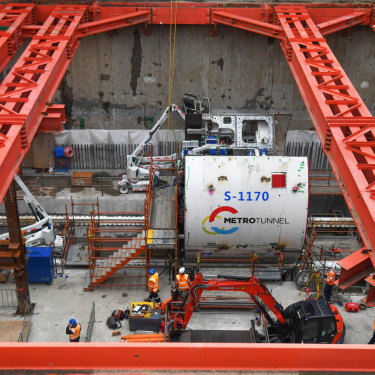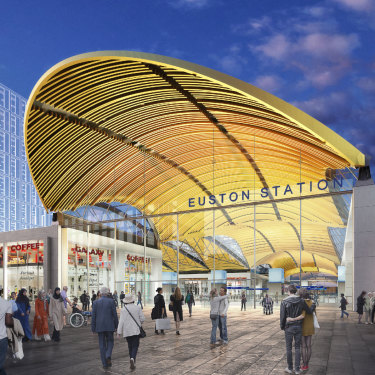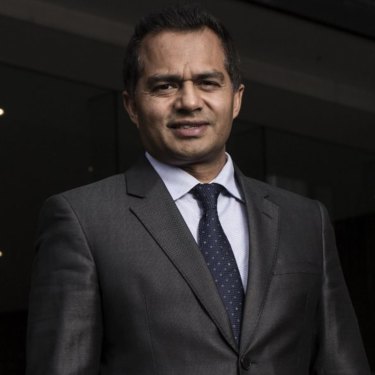For a man who makes cities, Lendlease chief executive Steve McCann loves the country vibe.
Perhaps it’s because his home in Duffys Forest on Sydney’s suburban fringe is far from the worries of town, where questions abound about the development and construction giant’s troubled engineering department.
Those worries include increasing concerns about delays and a cost blowout of at least $2 billion on the Melbourne Metro rail tunnel project, and an investor class action over the company’s handling of the NorthConnex road project in Sydney.
McCann’s home, a sprawling mansion used in the Biggest Loser TV series, also comes with plenty of area to care for the thoroughbreds he owns and co-owns with the likes of retail magnate Gerry Harvey and Quicksilver founder Alan Green.
McCann’s affection for his ponies, or as he puts it, “horses I am in love with”, is palpable. Asked if there is a favourite horse, one that he owns or that he as a keen punter has backed to a big win, McCann is quick to answer.
“I do have a favourite horse. It is in fact in my backyard.”
Its name is Unordered, an ageing chestnut gelding with four race wins under its belt.
“It’s my favourite horse because it is the first horse I ever personally picked out at a yearling sale and inspected and decided to buy. And he could run a bit but he had pretty weak legs. He’s very happily retired in my backyard.”
Unordered (in orange) running second at Royal Randwick in 2008.Credit:Adam Hollingworth
Retirement does not seem to be on the cards for McCann despite the challenges he is facing. At only 54 years old, he’s still fit and healthy despite sporting two broken bones in his foot (a “non-sporting injury”, he jokes) when sitting down for an exclusive interview with The Age and The Sydney Morning Herald.
After ten years in the job and the company’s embarrassing recent stuff-ups in its engineering arm, there is talk in market and property circles that perhaps Lendlease’s big boss could hang up his hard hat – voluntarily or otherwise.
“He’s been one of the finest leaders in the sector. It’s a shame that after 10 years there is this cloud over his head,” says one investment banker who has followed the group’s activities for years.
In a meeting room at Lendlease’s offices overlooking Sydney Harbour in Tower 3 Barangaroo South, McCann acknowledges the situation.
“Now look.. there’s a lot of focus on the negative at the moment, but we’ve got a lot of good things to talk about.”
He has a point. To paint McCann only as a man with problems is to not present the full picture.
Barangaroo in Sydney is one of Lendlease’s biggest projects.Credit:Peter Braig
There are great parts to his legacy. Not only has he carried Lendlease through bigger storms, including the near Armageddon that wracked commercial property markets in 2009, he has overseen massive growth in its development pipeline and city-shaping projects like Barangaroo South in Sydney and Elephant Park in London.
Lendlease has a $75 billion development pipeline speckled with jewel urbanisation projects, any one of which would inspire envy in a rival developer. There are awards for safety and environmental outcomes as well as a relatively happy unionised workforce in a sector often characterised as rife with industrial conflict.
And a share price at $13.48 that, while depressed in the past 18 months, is a long way from the $4.87 dark days when McCann took up the top job. In fact, total shareholder returns from June 30, 2008 to June 5 (excluding reinvestment of distributions) sit at a staggering 106 per cent. On Bloomberg’s reckoning, which uses slightly different metrics, the total return for Lendlease is even better at 145 per cent over that time frame compared to 129 per cent for the ASX200 over the same period.
It’s not bad for a boy raised in a large family in Glenroy, a northern suburb in Melbourne that at the time was a tough neighbourhood.
Love of numbers
The Adelaide-born McCann had a love of numbers from an early age. After graduating from the Christian Brothers’ St Bernard’s College in Essendon in the early 1980s, McCann worked as a bookies clerk and at a chartered accounting firm to put himself through university.
Credit:Illustration: Joe Benke
At the Flemington track, the fresh-faced 18 year-old wowed his boss as he speedily worked out the risk taken by the bookie on each bet.
After a decent stint in investment banking at ABN Amro, McCann joined Lendlease in 2005 – first as head of investment and later as chief financial officer before his elevation to the top job in 2009 during a tough period for the group.
Ten years on, and Lendlease is again facing serious troubles.
In November, it booked a $350 million writedown on its engineering business due to issues in three road infrastructure projects – the NorthConnex project in Sydney and the Gateway Upgrade North and Kingsford Smith Drive, both in the Brisbane area.
Loading
It was surprising to say the least, and came only months after the first of a series of glowing reviews had declared that McCann had enjoyed “ten years at the top”. The impairment took total engineering provisions to $500 million. Lendlease’s shares tumbled on the news to $14.25 after closing strongly the day before at $17.45, sparking a class action by investors.
The pain wasn’t over. At its half-year results in February, Lendlease announced it would sell its engineering business and predicted the sale process would see it incur an additional pre-tax provision of between $450 million and $550 million for the restructuring costs and to close out contracts with customers.
Its net profit after tax for the first half was a dismal $15.7 million, compared to the $425.7 million it reported a year earlier.
Operating cash flow for the period was negative, as the company spent $842 million more cash than it brought in during the half. On an underlying basis, an adjusted cashflow metric preferred by Lendlease, the figure was better at negative $164 million.
Speculation of a takeover by an Asian group has cooled any shortseller attack that may have been planned for the market darling, though the company is on the lookout and McCann seethes at potential “market manipulators”.
“I’m not aware of anything that is a concern. As a general statement, market manipulation is not appropriate or helpful to anybody… the market will be better off without it.”
Still, there are growing rumblings Lendlease will book more provisions, with all eyes on Melbourne Metro.
Loading
Lendlease is part of the Cross Yarra Partnership (CYP) responsible for the $6 billion tunnels and rail stations stage of the $11 billion Melbourne Metro project. The company’s share of that stage is $1.7 billion.
Several well-placed sources representing a variety of stakeholders in the Melbourne Metro rail project talk of significant delays. Some say the consortium underquoted the tunnelling project by as much as $2 billion. Others say the cost blowouts could be in the nine-figure range.
“It’s because of the type of soil,” says one source close to the project, referring to the dense river silt the project has to dig through in some parts.
Another source who has recently visited the site said: “They (representatives of CYP) are openly telling staff on site that the project is not on budget.”
An on-site source said the consortium has struggled to find enough senior engineers to operate the project on time. “There is a lack of experienced supervision. They‘ve got ‘kids’ on site doing big jobs.”
Industry feedback suggests the initial works have not progressed as originally forecast.
Macquarie’s Rob Freeman
Macquarie analyst Rob Freeman is factoring in an around 17 per cent cost overrun for Lendlease’s costings. An estimate he describes as “conservative”.
This would indicate a $300 million blowout for Lendlease alone, he predicts. Freeman’s estimates could indicate an at least $1 billion blowout for the consortium of the $6 billion project value.
“Melbourne Metro is the main unknown…(there’s a) risk of a provision here.
“Industry feedback suggests the initial works have not progressed as originally forecast. While not related to tunnelling, a more recent example is the Sydney light rail project which has seen an about 110 per cent cost overrun.”
Metro Tunnel’s North Melbourne siteCredit:Joe Armao
This was not a Lendlease project and a potential bright spot is that the NSW government settled a year-long legal dispute with subcontractor Acciona for $576 million.
This week the Victorian Auditor General Andrew Greaves found the cost of early construction work on the $11 billion Metro Tunnel is set to inflate by $150 million. This was in part because of cost overruns at the State Library site.
He warned that the government’s quickly depleting pool of back-up funds was an “early warning flag” that costs were blowing out.
“With at least five years of complex and risky construction to go, this raises some risk that the project may exceed the publicly announced $11 billion budget,” he said.
But the government was upbeat. “[The] overall project is within project budget,” Victorian Transport Infrastructure Minister Jacinta Allan said this week.
Victorian Treasurer Tim Pallas on Friday didn’t question reports in the Age and Herald that the project could be facing a $2 billion overrun, insisting instead that the state wouldn’t pay the bill for a blowout under the project.
Transcripts from an analyst call in November show McCann saying Metro had “started a little more slowly” than expected.
McCann bristles when asked directly about the project, including rumours of an impending writedown, rumoured delays, cost overruns and the Macquarie note.
“Melbourne Metro is a very large project with a long way to go. It’s a commercial arrangement that is in confidence and we don’t comment on individual projects.”
Melbourne Metro is a very large project with a long way to go. It’s a commercial arrangement that is in confidence and we don’t comment on individual projects.
Lendlease’s Steve McCann
But he does address some issues, “speaking broadly” across the industry. First the lack of senior engineers.
“We just don’t have enough really high quality engineers coming through. But we are now, I think collectively, doing a lot more on that regard, but we should have gotten onto that earlier.”
There’s also the troubles with tunnels.
“The challenges with what you are dealing with under the ground are far less known and far less manageable that what happens above the ground,” he said.
“I think there is quite a difference and I think that’s one of the challenges that a lot of businesses have had in recent years.
Loading
“How do you appropriately price the contingency required for those risks? It’s very challenging.”
Lendlease has also faced headaches in the past 18 months over other projects, notably the NorthConnex project in Sydney, which was written down in its November trading update.
There are questions over the timing of that announcement.
Accounts for the year ending December 31, 2017 filed by an Australian arm of Lendlease’s project partner Bouygues dated June 22, 2018 indicate the project had clear problems months before Lendlease confessed to its shareholders.
In the section titled “significant events after the reporting date” the accounts state: “Subsequent to year end, the Northconnex project suffered further deterioration in profitability due to unforeseen events that occurred during the December 31, 2018 year.”
The amount of the profit downgrade does not appear to be referenced in the accounts for that year or the next, which sources say could indicate the lack of materiality of the profit hit.
Lendlease declined to comment. The group did first flag potential provisions on select projects without naming NorthConnex specifically in a market update in October 2017.
While McCann won’t talk specific projects like NorthConnex or Melbourne Metro, he is open about the problems within the engineering business and why Lendlease is looking to get out.
“Fundamentally it’s a market that has a number of risk attributes that are not really consistent with our broader risk profile as a company,” he says.
He also freely admits that there are regrets associated with Lendlease’s purchase of Valemus in 2011, from which its engineering business was borne.
It’s not the first time Lendlease has run into trouble with its engineering arm. A group of senior executives fell on their swords after accounting abnormalities were revealed in its Abigroup business in 2012.
“I regret the fact that it’s underperformed,” says McCann. “Clearly, I think the rationale was sound at the time but it just hasn’t worked out the way we had anticipated at all.”
“So we were bidding on projects in an aggressive bidding environment and when things go wrong on those projects they can be very difficult to turn around.
“But in our broader business there are a lot of levers to mitigate risks. Even when things do go wrong.”
After the engineering business sale process, which McCann says is going well, Lendlease will further its development record.
Euston Station is on the slate for Lendlease.
McCann is rightfully very proud of the group’s series of major urbanisation project wins. The list is huge and impressive.
There’s the $14 billion Thamesmead urban regeneration project in London, the $2.7 billion Birmingham Smithfield development, the $6.2 billion Silvertown Quays redevelopment scheme in the former London docklands, the $10.5 billion redevelopment of Euston station in London.
It’s just a slice of the group’s massive pipeline that spans America, Europe, England and Australia and includes major domestic projects like Batman’s Hill in Melbourne, Barangaroo South and Darling Harbour Live in Sydney and more projects in Brisbane.
Underpinning these massive projects is a hungry crowd of 150 investment partners.
Obviously that pipeline needs a lot of capital. We have a great base of investors who support us around the world.
Steve McCann
“Our backlog now sits at $75 billion. So it’s a very significant development pipeline that underpins the business for the next 10 to 15 years,” McCann says.
“Obviously that pipeline needs a lot of capital. We have a great base of investors who support us around the world.”
In the past four years, Lendlease has doubled its wholesale fund business to $34 billion funds under management. One market source describes it as one of McCann’s key achievements.
“So, having that access to investors and having investors who are prepared to back our track record enables us to play at a scale that delivers those sorts of outcomes and I think it’s a big differentiator,” he says.
Recent examples of big investments includes industry fund First Super’s commitment to a $US1 billion investment fund to a build-to-rent project in gateway cities in the US and its $2.7 billion build-to-rent partnership with the Canada Pension Plan Investment Board in the UK.
“You will see a very significant shift in terms of the mix of earnings between investment management and development,” McCann predicts. “Construction will clearly be a smaller component of that post the separation of the engineering business.”
McCann’s ability to ride out storms is well known. His contract was renewed in 2013 on an ongoing basis with no fixed term.
Nick Collishaw, who was named CEO of Mirvac in 2008 and is now a director of property outfits Lincoln Place and Centuria Funds Management, has nothing but praise for his one-time competitor and peer over his resolve.
“We both had to steer our organisations through very difficult financial times. Steve was very pragmatic in his approach and settled the business down a bit. We did speak quite a few times as all CEOs did during that period to see what we could learn from each other. He did a very good job in that.”
While Collishaw left Mirvac in 2012, McCann appeared firmly planted in his position. This is despite surrounding himself with an executive team full of would-be successors including CFO Tarun Gupta, CEO property investments Australia Kylie Rampa and CEO Americas Denis Hickey.
Tarun Gupta is one of the potential candidates to takeover as CEO.Credit:Photo: Dominic Lorrimer
“The reality is that it’s a great company and I’m happy to be leading and I’m happy to continue leading it as long as people want me to,” he says.
“Having said that, I’ve also spent a lot of time developing successors to me who are high quality and there a lot of options in my view there.”
New chairman Michael Ullmer and his board will no doubt have an eye to all of this when considering the company’s future leadership. And the departure of long-time Lendlease chairman and McCann ally David Crawford could signal a full changing of the Lendlease guard.
McCann points out that, like his proudest achievement, Barangaroo South, many of Lendlease’s projects have a start to finish date of more than 10 years, so it makes sense to keep a team in place longer than other companies would.
“I think you have to take a longer term view on your investment horizon if you’re in a business like Lendlease, and it probably translates into a longer term view on of the people from the CEO down.”
So is it time for the man so often described as the smartest person in the room to stand down? No doubt, he will have weighed the odds.



